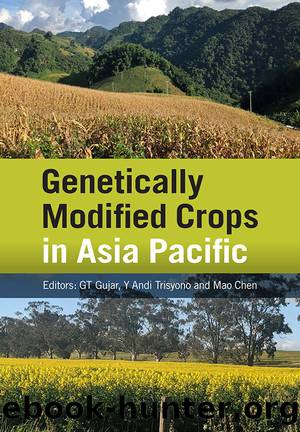Genetically Modified Crops in Asia Pacific by Mao Chen;G Gujar;Y Andi Trisyono;

Author:Mao Chen;G Gujar;Y Andi Trisyono;
Language: eng
Format: epub
ISBN: 9781486310920
Publisher: CSIRO Publishing
Published: 2020-12-15T00:00:00+00:00
GM safflower
GM safflower is a recent addition to the list of commercialised GM oilseed crops in Australia, licensed in June 2018. GM safflower expresses high oleic acid in its oil. In Australia, the commercial safflower cultivars are classified into two groups: linoleic varieties with 70â75% linoleic acid and oleic varieties with 70â80% oleic acid (Singh and Nimbkar 2006). An oleic acid class safflower cultivar, M1582 (originally from Mexico), was used as the parent cultivar for the released GM safflower. However, this particular cultivar is currently not cultivated in Australia (OGTR 2018c).
GM safflower was developed by modifying the fatty acid synthesis pathway to decrease the linoleic acid and increase the oleic acid in the safflower oil. This was done via modified expression of the two endogenous genes â Palmitoyl-ACP thioesterase (CtFATB) and Î12 desaturase (CtFAD2.2) â involved in the fatty acid biosynthesis pathway. CtFATB encodes a carrier protein that mediates the export of saturated fatty acids from the plastid (Bonaventure et al. 2003) whereas CtFAD2.2 encodes a desaturase protein that converts enzymatically oleic acid to linoleic acid (Harwood 1996). These genes were suppressed by using RNAi technology. Suppressing expression of CtFATB resulted in the formation of oleic acid by retaining the saturated fatty acids in the plastid until their desaturation. Suppression of expression of CtFAD2.2 increased the oleic acid in the oil by preventing the conversion of oleic acid into linoleic acid (Wood et al. 2018).
GM safflower seeds produce oil which has ~92% oleic acid. This high-purity oleic oil has applications as an industrial raw material and a replacement for petroleum-based oils in the manufacture of plastics, lubricants and cosmetics (Vanhercke et al. 2013). It is approved for use in the industrial oil market, and not for human consumption. The meal produced after oil extraction can, however, be used as a stock-feed.
Download
This site does not store any files on its server. We only index and link to content provided by other sites. Please contact the content providers to delete copyright contents if any and email us, we'll remove relevant links or contents immediately.
Machine Learning at Scale with H2O by Gregory Keys | David Whiting(4178)
Never by Ken Follett(3790)
Fairy Tale by Stephen King(3220)
Will by Will Smith(2792)
Hooked: A Dark, Contemporary Romance (Never After Series) by Emily McIntire(2497)
The Dawn of Everything: A New History of Humanity by David Graeber & David Wengrow(2122)
The Becoming by Nora Roberts(2087)
The Strength In Our Scars by Bianca Sparacino(1776)
HBR's 10 Must Reads 2022 by Harvard Business Review(1776)
A Short History of War by Jeremy Black(1762)
Go Tell the Bees That I Am Gone by Diana Gabaldon(1687)
515945210 by Unknown(1599)
A Game of Thrones (The Illustrated Edition) by George R. R. Martin(1588)
Bewilderment by Richard Powers(1538)
443319537 by Unknown(1470)
The 1619 Project by Unknown(1384)
The Real Anthony Fauci: Bill Gates, Big Pharma, and the Global War on Democracy and Public Health (Childrenâs Health Defense) by Robert F. Kennedy(1366)
How to Live by Derek Sivers(1319)
I Will Find You by Harlan Coben(1273)
